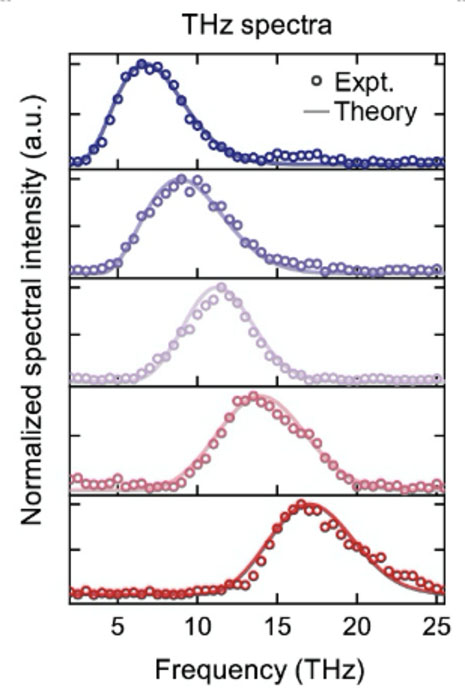| Feb 03, 2023 |
A novel ultrashort terahertz pulse generation scheme in diamond
(Nanowerk News) The advent of intense ultrashort coherent light pulses has revolutionized the spectroscopy field. On the one hand, they allow easy observation of various nonlinear optical effects and facilitate the characterization of materials with nonlinear optical spectroscopy. On the other hand, they provide means for strong selective excitation of materials and optical manipulation of material structure. It also enhances properties such as optical-field-induced ferroelectricity, and superconductivity. They have also created the vibrant field of ultrafast dynamics of low-frequency excitations in materials.
|
|
Thanks to advances in laser technology over the past decades, intense femtosecond (fs) pulses from table-top setups are now available over the whole spectral range from ~10 THz to soft X-ray, even in ordinary laboratories.
|
|
Below ~5 THz, high-intensity picosecond pulses exist, but between 5 and 12 THz, stable, continuously tunable, energetic fs pulses are more challenging to come by. However, this is a spectral range of great importance for materials studies.
|
|
Phonons and vibrations of molecules and solids composed of heavier atoms are in this range, and so are the intermolecular vibrations of molecular systems in chemistry and biology. Various elementary excitations of solids also lie in this spectral region.
|
|
In a new paper published in Light: Science & Application ("A novel scheme for ultrashort terahertz pulse generation over a gapless wide spectral range: Raman-resonance-enhanced four-wave mixing"), a team of scientists led by Professor Y. Ron Shen from the University of California Berkeley and Professor Chuanshan Tian from Fudan University have developed a novel technique for generating ultrashort tetrahertz pulses.
|
 |
| THz output spectra: The top-to-bottom frames present spectra obtained with beam geometries set to yield different center THz frequencies. Solid curves are theoretical fits. (Image: Jiaming Le, Yudan Su, Chuanshan Tian, A. H. Kung, Y. Ron Shen)
|
|
Currently, optical rectification (OR) or difference frequency generation (DFG) in second-order nonlinear crystals is the standard technique to generate intense THz pulses. However, THz generation from crystals is limited because of phonon absorption. Organic nonlinear crystals have been used for efficient THz generation, but they have only a few narrow transparent windows above 5 THz and suffer from low optical damage thresholds.
|
|
Laser-induced gas plasmas can generate energetic THz pulses. They are well suited as probes for linear THz spectroscopy over a wide spectral range. However, their complex spatial mode patterns make them less desired as pumps for strong resonant excitations. Free electron lasers and electron-driven THz sources can also produce fs pulses covering the entire THz spectral range, but they are not readily available for most researchers.
|
|
Diamond has many attractive merits. Its high optical damage threshold allows input pump intensities to be so high as to induce third-order nonlinear optical effects (e.g., four-wave mixing) that can compete with second-order effects (e.g., DFG) in other crystals. Transparency throughout the region from THz to UV leads to weak frequency dispersion of optical response coefficients that facilitates phase-matched THz pulse generation over an extensive spectral range. Moreover, the Raman phonon resonance is strong and has a long lifetime, greatly enhancing the third-order nonlinearity of diamond on the fs time scale.
|
|
Resonant four-wave mixing (R-FWM) for fs THz pulse generation in a diamond can be considered a beating process between an fs IR pulse with a coherent phonon wave that is Raman-excited by two ps input pulses. The process down-converts the fs IR pulse by the phonon wave to the fs THz pulse. The energy conversion efficiency is given directly by the output THz pulse energy ratio to the input fs pulse energy.
|
|
The research team measured THz pulse generation with the center frequency from 5 to 20 THz. This spectral range can be readily extended to >100 THz. Since the THz radiation efficiency increases with the square of the frequency, there is more pulse energy at a higher input frequency. The research team hypothesizes that the output THz energy generated by R-FWM in a thicker diamond can reach a level comparable to that generated by DFG in GaSe or other crystalline compounds, especially at higher THz frequencies.
|
|
Their study has unequivocally established that R-FWM in a diamond can be made into a high-quality, powerful, fs THz generator over a wide spectral range without any gap. As a direct frequency down-conversion process via the Raman-excited phonon wave, R-FWM generates fs THz pulses that duplicates the input fs IR pulse except for a shift in frequency and some modification due to radiation efficiency. An input pulse of high quality generates a THz pulse of nearly equal high quality. Tuning the characteristics of the input pulse tunes the characteristics of the THz output pulse accordingly. In this respect, the researchers could amplitude- or polarization-modulate the THz pulse simply by modulating the input pulse.
|

